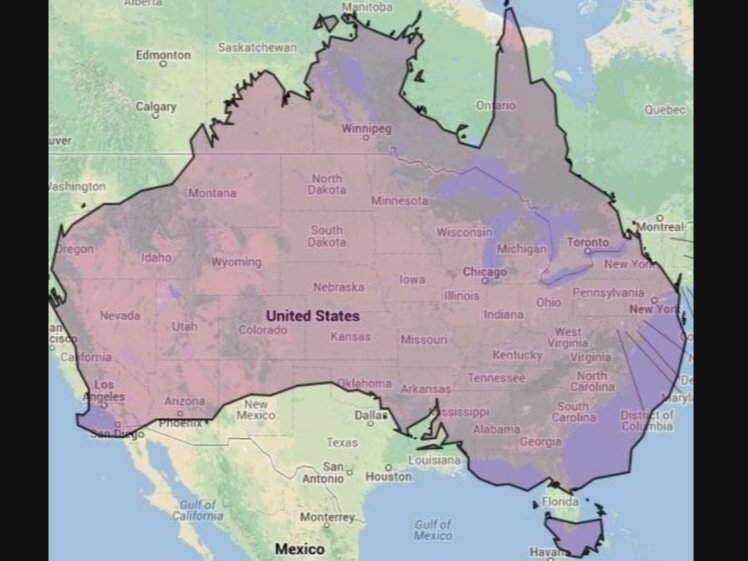Understanding the Scale: Comparing Australia’s Size to America
G’day, lovely folks! If you’re a parent planning to bridge the gap between the Land Down Under and the Land of the Free, understanding the relative sizes of Australia to America is key. Whether you’re dreaming of kangaroo hops or eagle flights, this guide is curated to give you the lowdown on what to expect when comparing the two. So, strap in your seatbelts as we embark on this geographical journey!
Size Matters: A Geographical Overview
First off, let’s talk about size. Australia is often colloquially referred to as the “Island Continent” due to its unique position—it’s the world’s largest island and the smallest continent. On the other side of the Pacific Ocean, we have the United States of America, sporting one of the largest land areas in the world. But how does Australia’s size really stack up to America?
Digging into the details, Australia has a land area of approximately 7.692 million square kilometers. In comparison, the United States, including Alaska and Hawaii, covers about 9.834 million square kilometers. While both countries boast vast landscapes and diverse environments, the United States is notably larger by land area.
As a parent, recognizing the differences in the size and scale of these countries can help in planning trips, understanding travel times, and appreciating the rich diversity each country offers. So pull out your maps, and let’s explore the splendor of these two nations hand in hand.
Cross-Country Comparisons: State by State
Now let’s zoom in a little. How do individual states in the U.S. compare to entire Australian states and territories? This is where things get super interesting!
For example, did you know that Texas, the second-largest state in the U.S., would snugly fit into Queensland with room to spare? Or that Western Australia, Australia’s largest state, is about 3.5 times the size of Texas? Such comparisons can truly put the vastness of Australia’s terrain into perspective for our American friends.
Understanding these comparisons can also make a world of difference when it comes to planning activities. Should you be bracing for lengthy road trips across the Australian outback, or preparing for the bustling city vibes in American metropolises?
A Tale of Two Climates
The sheer size of both countries means you’re looking at a kaleidoscope of climates when hopping from one to another. In the U.S., climates run the gamut from the tropical warmth of Hawaii to the frigid colds of Alaska. Australia, meanwhile, predominantly basks in temperate and tropical weather, with extremes like the snowy mountain regions and the scorching Outback.
Preparing for climate differences is pivotal, particularly for families acclimated to specific weather patterns. Understanding the varying climates will ensure that your family is well-equipped for the sunny shores of California or prepared to tackle the arid deserts of the Australian interior.
Populating the Land: City Sizes and Beyond
When sizing up the differences between Australia and America, you can’t overlook population density. While the U.S. boasts bustling metropolises like New York City and Los Angeles, Australia’s urban centers like Sydney and Melbourne encapsulate a high percentage of the country’s population in fewer, but still vibrant cities.
Knowing how population size and distribution diverge in the U.S. and Australia is essential, especially if you’re a family in love with urban exploration or seeking more peaceful, secluded spots. Tailor your travels with the assurance that city sizes and the spaces between them greatly influence your escapades.
Whether you’re mapping out future travels or simply sating your curiosity about these two magnificent nations, the comparison of Australia’s size to America is a vast and vivid tapestry that’s waiting for you to unravel. So let’s keep this journey of discovery going, and dive even deeper into the fascinating aspects that make up the character and scale of Australia and America!

5 Things Parents Should Know When Preparing for the Size Difference Between Australia and America
1. Planning for Travel Times
Travel times can be a surprise for families used to the closer confines of the U.S. East Coast or the compact nature of European countries. In Australia, it’s not uncommon for flights from Sydney to Perth to take around five hours – similar to a cross-country flight in the U.S. from New York to Los Angeles. A bit of prep talk with the little ones about the lengths of journeys will make long travels manageable and fun!
2. Embracing the Great Outdoors
Both nations are famous for their natural wonders and outdoor activities, yet the scale can vastly change experiences. From the sprawling Grand Canyon to Australia’s Great Barrier Reef, the sizes of these wonders require different approaches. Consider the extent of time and physical effort the family can invest in these massive attractions to make the most out of your adventures.
3. Preparing for Regional Variances
Both countries’ vast sizes mean regional variations in culture, accent, customs, and even food. It’s like hopping between different worlds as you move from state to state. Helping your family appreciate these distinctions will enrich your travel experience and cultural understanding, turning a standard trip into an unforgettable journey.
4. Anticipating Health and Safety Needs
In the U.S., you can find convenience stores and pharmacies just around the corner, while in some parts of Australia, especially in the Outback, facilities can be few and far between. Packing a well-stocked first-aid kit, sufficient supplies of prescription medications, and understanding the location of medical facilities become crucial when traversing the isolated stretches of the Australian landscape.
5. Adjusting to Different Time Zones
Moving between the U.S. and Australia isn’t just a spatial shift – it’s a temporal one too! With multiple time zones across these expansive lands, it might lead to a case of jet lag or scheduling confusion. It’s smart to prepare your family’s internal clocks for the change and keep a handy time zone conversion chart to stay in sync with friends and relatives back home.
With each nation’s extensive dimensions comes a wealth of experiences awaiting families eager to explore. Whether it’s a chill day by Bondi Beach or a thrilling trek through the Appalachian Trail, the grandeur of Australia and America promises memories that will stretch just as far as their horizons. So, ready the globes, travel apps, and planners – adventures in these colossal corners of the earth are yours to seize!
Parting Tips for Parents Handling the Hop
To sweeten the deal and iron out the kinks, here are a few tidbits to help you navigate the great expanses of Australia and America:
- Consider travel insurance to cover unexpected delays and cancellations.
- Pack versatile clothing to layer up or strip down as climates can vary widely within each country.
- Invest in a reliable international data plan or local SIM cards to keep your GPS and travel apps at your fingertips.
- Teach your children about time management and patience, as the distances can mean prolonged periods of travel.
- Remember the value of journeys as family bonding experiences – storytelling, games, and shared playlists can turn travel time into treasure time.
Embrace the diversity, relish the road trips, and enjoy the vast tapestry of landscapes and lifestyles that Australia and America offer. After all, it’s not just about the destinations but the delightful detours and endearing escapades you’ll encounter along the way!
For more great articles please see here. For more information see here
Disclaimer
The articles available via our website provide general information only and we strongly urge readers to exercise caution and conduct their own thorough research and fact-checking. The information presented should not be taken as absolute truth, and, to the maximum extent permitted by law, we will not be held liable for any inaccuracies or errors in the content. It is essential for individuals to independently verify and validate the information before making any decisions or taking any actions based on the articles.




